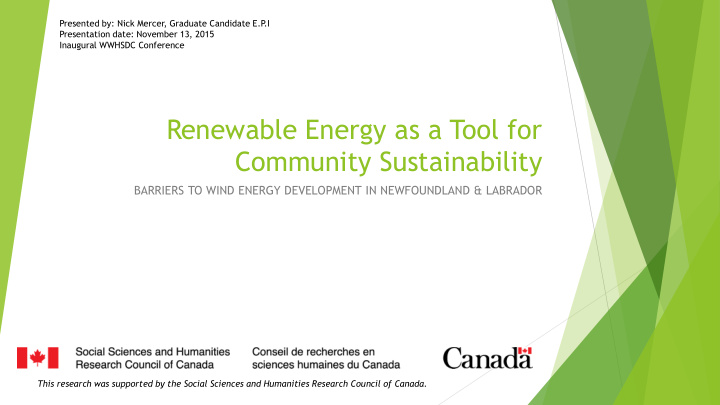



Presented by: Nick Mercer, Graduate Candidate E.P .I Presentation date: November 13, 2015 Inaugural WWHSDC Conference Renewable Energy as a Tool for Community Sustainability BARRIERS TO WIND ENERGY DEVELOPMENT IN NEWFOUNDLAND & LABRADOR This research was supported by the Social Sciences and Humanities Research Council of Canada.
Acknowledgements Thank you to my supervisory committee Co-Supervisors: Dr. Gabriela Sabau, Dr. Andreas Klinke Committee Members: Prof. Stephen Decker, Dr. Catherine Keske
Overview of Presentation 1) Renewable Energy as a Tool for Community Sustainability Strengthening our Communities Economic Sustainability 2) Current Research: A Case Study of Wind Energy Applying the ‘AKTESP’ Framework for Analysis Energy Overview Research Question/Objectives Methodology/Methods Work Completed Work to Be Done 3) Discussion & Questions
Renewable Energy as a Tool For Community Sustainability Energy Security Environment Public Health Affordability and Runaway climate IEA (05)’ fossil fuels: accessibility of change at 2 degree $254bn globally, energy increase. 450ppm triple by 2030 Demand rising Global peak 2015, USA: $120 bn/yr, (1.4%/yr until 2030) 50% cut below 2005 premature deaths IEA levels OPEC: 44% in 08’, 2050: 27% must be 52% in 2030 renewable RET reduces dependence
Economic Sustainability Cost Competitiveness Externalities Employment Increasingly cost Missing inputs & outputs 2010: 3.5mn jobs in RE competitive in costs Fast growth: 235k in NL: Holyrood (16- Fossil fuels $500-700bn wind 05’, 550k in 09’ 19c/kwh). Wind subsidies in 09’, $59bn RE creates 1.8-4x more (8c/kwh) RE jobs per MW installed 10% global (Satresa et al, 2011) health/disease burden Safer jobs: longer from air pollution, ½ employment, increased directly from burning human capital fossil fuels Diminished ecosystems, water scarcity, loss of agricultural land/yield Market price of coal - $0.09, w/ externalities $0.27, subsidies $0.27 (Epstein et al, 2011)
Barriers to Renewable Energy Development in Newfoundland and Labrador: A Case Study of Wind Energy Applying the AKTESP Framework for Analysis Supervisory Committee: Dr. Gabriela Sabau, Dr. Andreas Klinke, Professor Stephen Decker, Dr. Catherine Keske
Introduction: Potential NL: 18,000MW Identified & Developed RES. Consume ~1900MW. Significant Potential: Canadian Wind Energy Atlas, Focusing Our Energy Wind Resource Map: 117x demand Labrador: 5,000MW harvestable Third last in Installed Capacity: 54 MW – above NWT , Yukon
Fossil Fuels in Newfoundland and Labrador Energy Consumption Fiscally Dependent >27% provincial revenues from oil Holyrood Thermal Generating Station royalties (CAPP , 2014) 15-25%, rising to 35% $1 drop -> $30mn dollar loss 1.1mn tonnes GHG, 11k tonnes SO2 Detrimental to social programs and 21 Isolated Communities spending 15mn liters of diesel fuel/yr Others: Backup Gas Generators (127MW) #Dark NL -> 120MW Turbine
Research Question What are the barriers to renewable energy development in Newfoundland and Labrador? Research Objectives To apply a case-study approach that will enable an understanding of barriers to RED in NL. To apply the AKTESP Framework to enable an understanding of wind energy development in NL. To develop a policy framework that will help address complex barriers to renewable energy development in NL.
Research Methodology Grounded Theory Facilitates exploratory research Differs from traditional research: choose theoretical framework, collect data to prove it applies/doesn’t apply to phenomenon understudy Development of theory through analysis of data Repeated ideas -> codes -> categories. Categories may form basis for new theory
Research Methods: Data Collection Expert Interviews Semi Structured/Open-Ended Academia, community groups, private sector, government ‘AKTESP’ Framework for Analysis Does barrier impede progress to solution? Framework is continuous Sampling Methods *Expert sampling Snowball sampling
Research Methods: Data Analysis Interviews audio-recorded, manually transcribed Content Analysis Qualitative research technique Review text and ‘code’ into categories NVIVO: Advanced Qualitative Research Software Creation of transcripts, ‘nodes’, categories, text queries Identification of categories across participants
Work Completed Early work: Proposal, Lit. Review, Ethics Approval (GCREB), Participant Recruitment/Selection 15x Interviews to date
Preliminary Results (n=14) How Would You Describe the Current State of Wind Energy Development in Newfoundland and Labrador? Early Barriers Identified By Participants Agreement Knowledge Technological Economic Social Political
Work Remaining Five interviews remaining Continued data analysis Completion of thesis report
Selective Bibliography Epstein, P .R., Buonocor, J.J., Eckerle, K, Hendryx, M., Stout, B.M., Heinberg, R., Clapp, R. W., May, B., Reinhart, N.L., Ahern, M.M., Doshi, S.K. and Glustrom , L. (2011). “Full cost accounting for the life cycle of coal. Ecological Economics Reviews , 1219: 73-98. Department of Natural Resources. (2012a). Environmental Benefits of Closing the Holyrood Thermal Generating Station. Retrieved from http://powerinourhands.ca/pdf/muskratenvironment.pdf International Energy Agency. World Energy Outlook 2010. Paris, FR: OECD Publishing. Khan, M. J., & Iqbal, M. T . (2004). Wind energy resource map of Newfoundland. Renewable Energy, 29 (8): 1211-1221. Llera Sastresa, E., Aranda Uson, A.,Zabalza Bribian, I. and Scarpellini, S. (2010). Local impact of renewable on employment: assessment methodology and case study” Renewable and Sustainable Energy Review, 14(2010), 689-690. National Research Council (2010). Hidden Costs of Energy: Unpriced Consequences of Energy Production. Washington, D.C.: National Research Council. Newfoundland and Labrador. Department of Natural Resources. (2007). Focusing our Energy: Newfoundland and Labrador Energy Plan. St. John’s, NL . United Nations Environment Programme (2011). Towards a Green Economy: Pathways to Sustainable Development and Poverty Eradication. Retrieved from http://www.unep.org/greeneconomy/Portals/88/documents/ger/ger_final_dec_2011/Green %20EconomyReport_Final_Dec2011.pdf
Thank You Discussion & Questions?
Recommend
More recommend